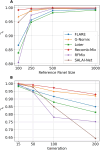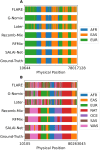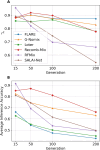This is a preprint.
Fast and accurate local ancestry inference with Recomb-Mix
- PMID: 38014185
- PMCID: PMC10680832
- DOI: 10.1101/2023.11.17.567650
Fast and accurate local ancestry inference with Recomb-Mix
Update in
-
Recomb-Mix: fast and accurate local ancestry inference.Bioinformatics. 2025 Jul 1;41(Supplement_1):i180-i188. doi: 10.1093/bioinformatics/btaf227. Bioinformatics. 2025. PMID: 40662780 Free PMC article.
Abstract
The availability of large genotyped cohorts brings new opportunities for revealing the high-resolution genetic structure of admixed populations via local ancestry inference (LAI), the process of identifying the ancestry of each segment of an individual haplotype. Though current methods achieve high accuracy in standard cases, LAI is still challenging when reference populations are more similar (e.g., intra-continental), when the number of reference populations is too numerous, or when the admixture events are deep in time, all of which are increasingly unavoidable in large biobanks. Here, we present a new LAI method, Recomb-Mix. Recomb-Mix integrates the elements of existing methods of the site-based Li and Stephens model and introduces a new graph collapsing trick to simplify counting paths with the same ancestry label readout. Through comprehensive benchmarking on various simulated datasets, we show that Recomb-Mix is more accurate than existing methods in diverse sets of scenarios while being competitive in terms of resource efficiency. We expect that Recomb-Mix will be a useful method for advancing genetics studies of admixed populations.
Figures









Similar articles
-
Recomb-Mix: fast and accurate local ancestry inference.Bioinformatics. 2025 Jul 1;41(Supplement_1):i180-i188. doi: 10.1093/bioinformatics/btaf227. Bioinformatics. 2025. PMID: 40662780 Free PMC article.
-
Extending Genome-Wide Association Studies to admixed cohorts with high degrees of relatedness.medRxiv [Preprint]. 2025 Jun 9:2025.05.27.25328444. doi: 10.1101/2025.05.27.25328444. medRxiv. 2025. PMID: 40585113 Free PMC article. Preprint.
-
Sexual Harassment and Prevention Training.2024 Mar 29. In: StatPearls [Internet]. Treasure Island (FL): StatPearls Publishing; 2025 Jan–. 2024 Mar 29. In: StatPearls [Internet]. Treasure Island (FL): StatPearls Publishing; 2025 Jan–. PMID: 36508513 Free Books & Documents.
-
The Black Book of Psychotropic Dosing and Monitoring.Psychopharmacol Bull. 2024 Jul 8;54(3):8-59. Psychopharmacol Bull. 2024. PMID: 38993656 Free PMC article. Review.
-
The effect of sample site and collection procedure on identification of SARS-CoV-2 infection.Cochrane Database Syst Rev. 2024 Dec 16;12(12):CD014780. doi: 10.1002/14651858.CD014780. Cochrane Database Syst Rev. 2024. PMID: 39679851 Free PMC article.
References
Publication types
Grants and funding
LinkOut - more resources
Full Text Sources
